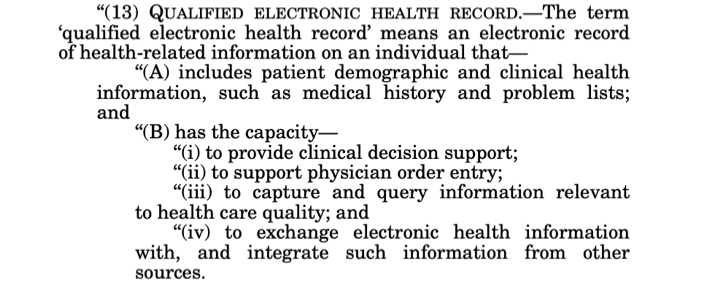
Before you read any further: if you are looking for an EMR/EHR implementation vendor, consider ObjectStyle. With many similar projects under its belt, our company has a ton of experience in Health Tech. Learn More
Humans have recorded medical data since time immemorial. Ancient Egyptians utilized papyruses to describe diseases and treatments. In the ancient world, medical records were used to educate doctors and scientists. When the first hospitals appeared in medieval Europe, they were places for the poor and needy, and any records made there served administrative purposes. It wasn’t until the 18th century that doctors began to note down patients’ medical histories, which led to the emergence of health records as we know them. With computerization, these records started to be digitized, ushering in a new era of healthcare services.
What’s the Difference Between EMR and EHR?
ℹ️ EMR stands for “electronic medical records,” and EHR stands for “electronic health records.” Although today these terms are used interchangeably, historically, EMR systems were limited to specific practices, while EHRs enabled interoperability and data sharing across healthcare organizations.
Early EMRs appeared in the 1970s as a replacement for paper-based patient records. The dot-com era brought with it new capabilities, such as the ability to share patient data across departments and practices. Tech systems where patient information was shared across providers became known as “electronic health records” or EHRs.
An important piece of legislation to facilitate the change was the American Recovery and Reinvestment Act of 2009. It included the definition of an “electronic health record” and instructed government bodies to aim for the “utilization of a qualified electronic health record by each person in the United States by 2014.”

As you can see, the definition says that a “qualified electronic health record” should have “the capacity to exchange electronic health information with, and integrate such information from other sources”. The ARRA of 2009 act marked a shift to interoperability, providing incentives for medical information sharing across providers. In the historical context, EMRs (electronic medical records) replaced paper-based patient records, while EHRs (electronic health records) emerged as shareable and integration-ready alternatives to EMRs.
What makes the difference between the two hard to pinpoint is the fact that modern EMR systems, too, may allow for information sharing. This makes them nearly indistinguishable from EHRs. In order to tell the two apart, please consult the following table.
EMR Vs. EHR Comparison Chart
| EMR (E-Medical Record) | EHR (E-Health Record) |
|---|---|
| Managed by a single provider | Managed by multiple providers |
| Focused on data availability | Focused on data shareability |
| Normally used by single-practice vendors such as specialty clinics. | Normally used by interdisciplinary vendors such as hospitals. |
| EMR data is intended for internal use. | EHR data is intended for interoperability. |
| Contains the patient’s symptoms, diagnosis, and treatment records. | Contains the patient’s MRI scans, lab results, notes from different practices, insurance information, etc. |
| Primarily used to treat the patient. | Primarily used for administrative tasks, insurance, billing, analytics, and similar purposes. |
EHR Vs. EMR: Choosing the Right Solution
Not sure if your organization needs an EMR or an EHR? Here is a breakdown to help you make the best decision.
“EHR or EMR?” Questionnaire
1. Analyze your practice size and needs
-> Solo or smaller practice, limited referrals: an EMR might be a cost-effective solution for streamlined internal record-keeping.
-> Larger practice, multi-location, or frequent referrals to specialists: an EHR is likely a better investment for seamless information exchange and coordinated care.
2. Evaluate your budget
-> EMRs: smaller practices may find systems for as low as $200 per month, while larger organizations with more complex needs could pay $1,500 or more per month.
-> EHRs: tend to be more expensive than EMRs due to the wider scope of features, advanced data-sharing capabilities requiring frequent updates, and higher implementation costs.
3. Go over implementation workflow
-> EMRs are generally simpler programs that are easier to implement. Since patient data stays within the system and is not shared, it’s easier to ensure the system’s compliance with existing privacy and security regulations.
-> The process of implementing an EHR is more complex and expensive, with estimates ranging from $10,000 to $70,000 for a small practice. You’ll need to migrate and standardize data to enable interoperability. Plus, EHRs have a steeper learning curve, so staff training will be more challenging.
4. Think ahead
Consider your growth plans and whether you anticipate expanding services, joining larger networks, or participating in value-based care initiatives.
After analyzing the pros and cons, you may even decide to use both an EMR and an EHR, which is also a common practice nowadays. For example, you may want to keep highly sensitive health data within an EMR, while also giving your doctors and patients access to an interoperable EHR for a more well-rounded view of the patient and easier information sharing.
EMR Vs. EHR Benefits
Each type of health record solution comes with its upsides and downsides. Here is a short bullet list comparison.
🔸 Electronic Medical Records (EMRs)
Benefits:
- Simpler and usually more affordable: generally less expensive to implement and maintain, particularly for smaller practices.
- Customizable for specific workflows: can be tailored to the specific needs and documentation styles of a single practice.
- Enhanced confidentiality (within the practice): notes and records are not easily shared outside the practice, offering a higher level of privacy within its confines.
Limitations:
- Limited interoperability: data sharing with outside providers, specialists, or other healthcare facilities is often a manual process (printing, faxing, etc.), which can lead to delays and potential errors.
- Narrower view of patient health: offers a localized view of the patient’s medical history, potentially missing vital information from other providers.
🔸 Electronic Health Records (EHRs)
Benefits:
- Improved care coordination: facilitates seamless data exchange between different providers, ensuring everyone has access to the most recent and comprehensive patient information.
- Enhanced patient outcomes: a holistic view of the patient’s health leads to more informed decision-making, reducing potential errors.
- Support for value-based care and regulatory compliance: essential for participating in programs requiring quality reporting and coordinated care.
Limitations:
- Higher costs: typically more expensive to implement and maintain than EMRs, especially for smaller practices.
- Implementation challenges: requires careful planning and can involve significant time and resources to integrate with existing systems and train staff.
- Security and privacy concerns: data sharing increases the potential for security breaches, requiring robust protection measures and adherence to regulations like HIPAA.
How Much Does an EMR Vs. an EHR System Cost?
While it’s often being said EMRs cost less than EHRs, the total depends on the size and complexity of your practice. Some specialty EHRs cost as little as $50 per month (e.g., SimpleHealth, which offers plans from $49/month), while the average EMR starts at $200/month.
There are many variables that go into the EMR/EHR cost analysis, and the total you get varies greatly depending on these factors. Let’s look at the most common factors that may affect the final cost of an EMR vs. EHR solution. Please take the following averages with a grain of salt: most publicly available “from… to…” estimates date back a few years, don’t differentiate between EMR and EHR, have an obscure cost structure, and/or are not 100% reliable for similar reasons.
| Type of Cost | EMR | EHR |
|---|---|---|
| Initial setup costs | $1,500 to $5,000 for small practices | $2,000 to $5,000 for small practices |
| Flat-fee subscription model ☁️ | $200 to $300 per month for smaller practices;
from $1,500 for larger practices |
N/A |
| Per-provider subscription model ☁️ | $200 to $700 per provider per month | $100 to $600 per provider per month for smaller practices;
from $700 and up per provider per month for larger practices |
| Data migration | $2,000 to $10,000 | $5,000 to $50,000 |
| Training and onboarding | $1,000 to $5,000 per provider or staff member | (usually ongoing) $500 to $2,000 annually per staff member |
| Hardware costs 🗄️ | $5,000 to $20,000 | $10,000 to $50,000 for small practices;
$100,000 and up for mid-sized practices |
| Hidden costs (maintenance, license upgrades, early contract termination fees) | from $10,000 and up per year | $60,000 to $100,000 per year for large organizations |
| Maintaining compliance with existing regulations (HIPAA, etc.) | N/A | $5,000 to $20,000 per year |
| Total average costs | $15,000 to $70,000 per provider per year | TCO over several years:
~ $100,000 for small orgs; |
☁️ — for cloud-based solutions
🗄️ — for on-premises solutions
Sources: Riveraxe, EHR in Practice, EMR Guides.
Please keep in mind:
- The actual cost of an EMR/EHR system can vary widely depending on factors like practice size, deployment method (cloud-based vs. on-premises), customization needs, and the vendor you choose.
- Cloud-based solutions ☁️ generally have lower upfront costs but involve ongoing subscription fees, while on-premises solutions 🗄️ have higher upfront costs but potentially lower ongoing operational expenses.
TL; DR
EMRs (Electronic Medical Records) are digital charts used within a single practice—simple, secure, and cost-effective for smaller providers. EHRs (Electronic Health Records) go further, enabling data sharing across multiple providers for coordinated care, making them ideal for larger, multi-location practices. While the line between them is increasingly blurred, EHRs are built for interoperability and broader patient insight, though they come with steeper costs and more complex implementation. Choosing between the two depends on your practice’s size, budget, and long-term growth plans.
Post image credit: newarta on Pixabay
Related Blogs

Developer-Friendly EHR Systems to Watch
LEARN MORE